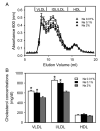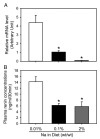Differential effects of dietary sodium intake on blood pressure and atherosclerosis in hypercholesterolemic mice
- PMID: 22705323
- PMCID: PMC3568659
- DOI: 10.1016/j.jnutbio.2012.03.001
Differential effects of dietary sodium intake on blood pressure and atherosclerosis in hypercholesterolemic mice
Abstract
The amount of dietary sodium intake regulates the renin angiotensin system (RAS) and blood pressure, both of which play critical roles in atherosclerosis. However, there are conflicting findings regarding the effects of dietary sodium intake on atherosclerosis. This study applied a broad range of dietary sodium concentrations to determine the concomitant effects of dietary sodium intake on the RAS, blood pressure, and atherosclerosis in mice. Eight-week-old male low-density lipoprotein receptor -/- mice were fed a saturated fat-enriched diet containing selected sodium concentrations (Na 0.01%, 0.1%, or 2% w/w) for 12 weeks. Mice in these three groups were all hypercholesterolemic, although mice fed Na 0.01% and Na 0.1% had higher plasma cholesterol concentrations than mice fed Na 2%. Mice fed Na 0.01% had greater abundances of renal renin mRNA than those fed Na 0.1% and 2%. Plasma renin concentrations were higher in mice fed Na 0.01% (14.2 ± 1.7 ng/ml/30 min) than those fed Na 0.1% or 2% (6.2 ± 0.6 and 5.8 ± 1.6 ng/ml per 30 min, respectively). However, systolic blood pressure at 12 weeks was higher in mice fed Na 2% (138 ± 3 mm Hg) than those fed Na 0.01% and 0.1% (129 ± 3 and 128 ± 4 mmHg, respectively). In contrast, mice fed Na 0.01% (0.17 ± 0.02 mm(2)) had larger atherosclerotic lesion areas in aortic roots than those fed Na 2% (0.09 ± 0.01 mm(2)), whereas lesion areas in mice fed Na 0.1% (0.12 ± 0.02 mm(2)) were intermediate between and not significantly different from those in Na 0.01% and Na 2% groups. In conclusion, while high dietary sodium intake led to higher systolic blood pressure, low dietary sodium intake augmented atherosclerosis in hypercholesterolemic mice.
Copyright © 2013 Elsevier Inc. All rights reserved.
Figures




Similar articles
-
Comparative effects of different modes of renin angiotensin system inhibition on hypercholesterolaemia-induced atherosclerosis.Br J Pharmacol. 2012 Mar;165(6):2000-2008. doi: 10.1111/j.1476-5381.2011.01712.x. Br J Pharmacol. 2012. PMID: 22014125 Free PMC article.
-
Deficiency of receptor-associated protein attenuates angiotensin II-induced atherosclerosis in hypercholesterolemic mice without influencing abdominal aortic aneurysms.Atherosclerosis. 2012 Feb;220(2):375-80. doi: 10.1016/j.atherosclerosis.2011.11.013. Epub 2011 Nov 19. Atherosclerosis. 2012. PMID: 22153700 Free PMC article.
-
Activation of the Renin-Angiotensin system mediates the effects of dietary salt intake on atherogenesis in the apolipoprotein E knockout mouse.Hypertension. 2012 Jul;60(1):98-105. doi: 10.1161/HYPERTENSIONAHA.112.191767. Epub 2012 May 29. Hypertension. 2012. PMID: 22647892
-
Activity of (des-Aspartyl1)-angiotensin II and angiotensin II in man. Differences in blood pressure and adrenocortical response during normal and low sodium intake.J Clin Invest. 1978 Jan;61(1):20-31. doi: 10.1172/JCI108919. J Clin Invest. 1978. PMID: 338631 Free PMC article. Clinical Trial.
-
Effects of dietary sodium on reactive oxygen species formation and endothelial dysfunction in low-density lipoprotein receptor-deficient mice on high-fat diet.Heart Vessels. 2008 Nov;23(6):420-9. doi: 10.1007/s00380-008-1066-5. Epub 2008 Nov 27. Heart Vessels. 2008. PMID: 19037590
Cited by
-
Renin-Angiotensin System and Cardiovascular Functions.Arterioscler Thromb Vasc Biol. 2018 Jul;38(7):e108-e116. doi: 10.1161/ATVBAHA.118.311282. Arterioscler Thromb Vasc Biol. 2018. PMID: 29950386 Free PMC article. Review. No abstract available.
-
Citrullus lanatus 'sentinel' (watermelon) extract reduces atherosclerosis in LDL receptor-deficient mice.J Nutr Biochem. 2013 May;24(5):882-6. doi: 10.1016/j.jnutbio.2012.05.011. Epub 2012 Aug 16. J Nutr Biochem. 2013. PMID: 22902326 Free PMC article.
-
Plasma metabolomics of children with aberrant serum lipids and inadequate micronutrient intake.PLoS One. 2018 Oct 31;13(10):e0205899. doi: 10.1371/journal.pone.0205899. eCollection 2018. PLoS One. 2018. PMID: 30379930 Free PMC article. Clinical Trial.
-
Sodium nitrate regulates senescence accompanied by aortic atherosclerosis in ApoE-/- mice through the miR-34a/FGF-21 axis.Front Pharmacol. 2025 Mar 5;16:1562321. doi: 10.3389/fphar.2025.1562321. eCollection 2025. Front Pharmacol. 2025. PMID: 40110129 Free PMC article.
-
Plasma renin activity in patients with heart failure and reduced ejection fraction on optimal medical therapy.J Renin Angiotensin Aldosterone Syst. 2017 Jul-Sep;18(3):1470320317729919. doi: 10.1177/1470320317729919. J Renin Angiotensin Aldosterone Syst. 2017. PMID: 28875746 Free PMC article.
References
-
- Meneton P, Jeunemaitre X, de Wardener HE, MacGregor GA. Links between dietary salt intake, renal salt handling, blood pressure, and cardiovascular diseases. Physiol Rev. 2005;85:679–715. - PubMed
-
- Horie R, Yamori Y, Nara Y, Sawamura M, Mizushima S, Mano M. Blood pressure levels in the elderly with or without nutritional intervention. J Cardiovasc Pharmacol. 1990;16(Suppl 8):S57–8. - PubMed
-
- Ketonen J, Merasto S, Paakkari I, Mervaala EM. High sodium intake increases vascular superoxide formation and promotes atherosclerosis in apolipoprotein E-deficient mice. Blood Press. 2005;14:373–82. - PubMed
-
- Ketonen J, Mervaala E. Effects of dietary sodium on reactive oxygen species formation and endothelial dysfunction in low-density lipoprotein receptor-deficient mice on high-fat diet. Heart Vessels. 2008;23:420–9. - PubMed
Publication types
MeSH terms
Substances
Grants and funding
LinkOut - more resources
Full Text Sources
Other Literature Sources
Medical

